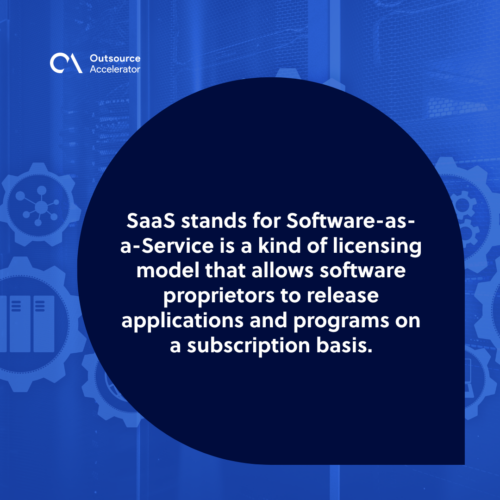Software-as-a-Service (SaaS)
Definition
What is SaaS?
SaaS stands for Software-as-a-Service. It’s a kind of licensing model that allows software proprietors to release applications and programs on a subscription basis. These apps’ servers are located externally rather than on-site.
Software-as-a-Service platforms can be accessed via web browsers such as Google Chrome, Microsoft Edge, Safari, and more. Aside from installing an app on their computer, users can access them with a working device and a stable internet connection.

The 2 types of SaaS
SaaS solutions take one of two paths: either vertical or horizontal. Here’s how they work.
Horizontal SaaS
Horizontal SaaS products are classified as “off-the-shelf” programs. They aim to cater to the general public (GSuite, Office365, Adobe) and provide solutions to businesses.
Examples include accounting software, marketing automation programs, and customer relationship management applications. GSuite, Office365, and Adobe are some of the more prominent names in horizontal SaaS.
Vertical SaaS
Programs under the vertical SaaS type are more specific and targeted. For instance, vendor management software is developed for staffing agencies and recruitment process outsourcing companies.
They cater to specific industries and provide services to each niche of the sector. Other examples may include medical technology programs, edtech apps, and retail management applications.
Pros of using SaaS platforms
The future is bright for SaaS. Here are the advantages it offers industries and individuals.
Accessibility
Most web-based applications are highly accessible, even for ordinary users. For instance, by using a browser-based project management platform, business executives from the US can assign tasks to their counterparts in the Philippines.
Cost-effectiveness
SaaS is also more cost-effective, perfect for small businesses and startup companies. Most of the time, a custom-made application can be a bit pricey for budding businesses.
Moreover, users can control how long the subscription should go for—these platforms usually have a per-month subscription. This setup allows their customers to have some flexibility in terms of membership.
User-friendliness
These platforms are developed with the users in mind. Web developers and designers collaborate with each other to come up with programs and features that will provide a solution to their target audience.







 Independent
Independent




